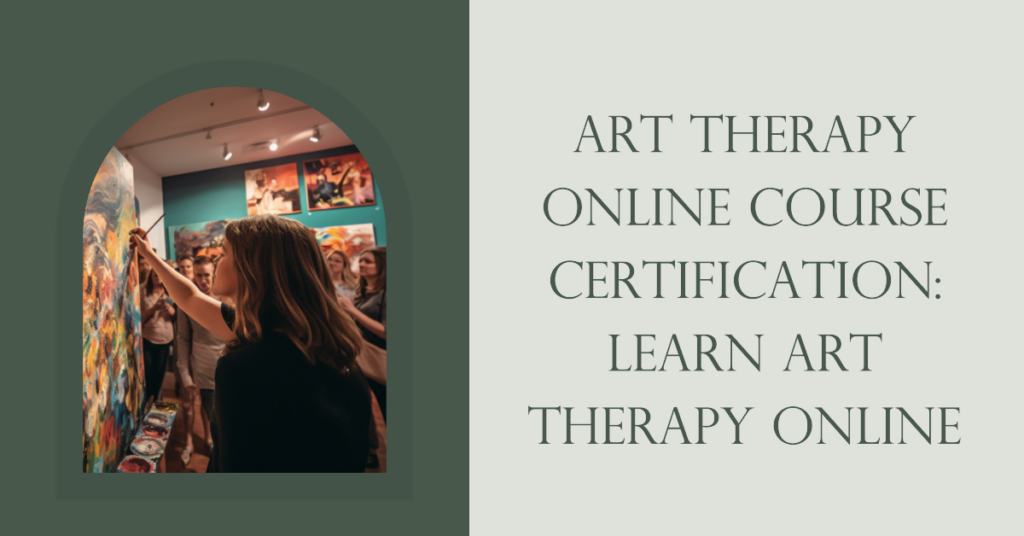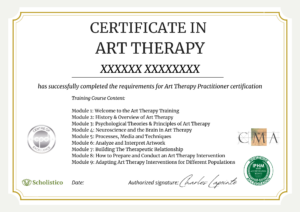Art Therapy Online Course Certification: Learn Art Therapy Online

Introduction to Art Therapy
History of Art Therapy
Art therapy has been used as a form of healing and self-expression for centuries. It gained popularity in the mid-20th century, as mental health professionals began to recognize its therapeutic potential. Art therapy combines traditional psychotherapy techniques with the creative process to help individuals explore their emotions, improve self-awareness, and cope with life challenges.
Benefits of Art Therapy
Art therapy offers numerous benefits, such as reducing stress, improving mental health, and promoting personal growth. It is particularly effective for those who struggle with verbal expression or have experienced trauma. By engaging in the creative process, individuals can develop a deeper understanding of their emotions and experiences, fostering healing and personal growth.
What are the 4 types of art therapy?
Four common types of art therapy include:
- Painting and drawing: These traditional art forms allow clients to express their emotions and explore their creativity.
- Sculpture and clay work: Working with three-dimensional materials can help clients process complex emotions and develop problem-solving skills.
- Collage and mixed media: Combining different materials and images allows clients to explore multiple aspects of their experiences and emotions.
- Digital art therapy: Utilizing digital tools and software can provide a versatile, accessible medium for clients to engage in art therapy.
Art Therapy Practitioner vs. Art Therapist
Educational Requirements
One of the main differences between an art therapy practitioner and an art therapist is the level of education required. Art therapists typically need a master’s degree in art therapy or a related field, as well as supervised clinical experience. Art therapy practitioners, on the other hand, may not need such an advanced degree. Instead, they can complete a certification program, like our product, which provides them with the necessary knowledge and skills to facilitate art therapy sessions in a non-clinical setting.
Scope of Practice
Another key difference between an art therapy practitioner and an art therapist is the scope of their practice. Art therapists are trained to work with individuals experiencing a wide range of mental health issues and can provide clinical diagnoses and treatment plans. Art therapy practitioners, while still equipped to guide individuals through therapeutic art activities, do not provide clinical diagnoses or treatment. Their role is more focused on facilitating personal growth, self-awareness, and emotional expression through the creative process.
Why Choose Online Learning for Art Therapy
Flexibility and Convenience
Online learning offers unparalleled flexibility and convenience. Students can complete coursework at their own pace and on their own schedule, making it an ideal choice for busy individuals, working professionals, or those with family commitments. Additionally, online learning eliminates the need for travel and associated costs, making education more accessible.
Access to Expert Knowledge
High-quality online art therapy courses, like our training course, provide access to expert knowledge and resources. Students can learn from experienced instructors and collaborate with peers from around the world, broadening their perspective and enhancing their learning experience.
Lower Cost
Online learning is often more affordable than traditional in-person courses, as there are no physical campus costs or overhead expenses. This allows students to invest in their education without incurring excessive debt.
Key Components of an Online Art Therapy Course
Course Curriculum
A comprehensive online art therapy course should cover essential topics such as art therapy theories, techniques, and applications. The curriculum should be designed to provide students with a solid foundation in both the theory and practice of art therapy.
Interactive Learning Materials
High-quality online courses should offer a variety of interactive learning materials, such as video lectures, readings, and quizzes. These resources can help students stay engaged and deepen their understanding of course content.
Practical Experience
Hands-on experience is crucial for aspiring art therapy practitioners. Online courses should provide opportunities for students to practice their skills through assignments, case studies, and supervised practice sessions. These experiences can help students build confidence and competence in their art therapy practice.
Accreditation and Certification
IPHM and CMA Accreditation
To ensure that you receive a high-quality education and that your certification is recognized, it’s important to choose an online course accredited by reputable organizations such as the International Practitioners of Holistic Medicine (IPHM) and the Complementary Medical Association (CMA).
Centre of CPD Excellence
Another mark of a high-quality course is accreditation by the Centre of CPD Excellence. This demonstrates that the course meets rigorous standards for professional development and continuing education.
Becoming an Art Therapy Practitioner
Certification and Licensing
After completing an accredited online art therapy course, you’ll need to obtain certification and any necessary licenses to practice as an art therapy practitioner. This may involve joining professional organizations, meeting continuing education requirements, and adhering to ethical guidelines. Learn more about the process in these posts.
Embracing Your Role
As a non-clinical art therapy practitioner, it’s essential to understand and embrace your unique role in facilitating therapeutic art experiences. Explore this concept further in this post.
Art Therapy Techniques
To be an effective art therapy practitioner, you’ll need to be well-versed in various art therapy techniques and activities, such as those designed to address anxiety or promote self-discovery. Develop your skills by learning and practicing a wide range of techniques.
Conclusion
Art therapy is a powerful tool for promoting healing, self-awareness, and emotional expression. As an art therapy practitioner, you can make a positive impact on the lives of others by guiding them through the creative process. By choosing a high-quality, accredited online course, you can gain the knowledge and skills needed to excel in this rewarding field.
- What is the main difference between an art therapy practitioner and an art therapist? The primary difference is the level of education and scope of practice. Art therapists require a master’s degree and can provide clinical diagnoses and treatment plans, while art therapy practitioners may only need certification and focus on facilitating personal growth and emotional expression through the creative process.
- Why should I choose an online course for art therapy? Online courses offer flexibility, convenience, and accessibility for busy individuals or those with limited resources. Additionally, online courses can be more affordable than traditional in-person programs.
- What should I look for in an online art therapy course? Ensure the course covers essential topics, provides interactive learning materials, and offers practical experience opportunities. Also, choose a course accredited by reputable organizations such as IPHM, CMA, and the Centre of CPD Excellence.
- Do I need a license to practice as an art therapy practitioner? Licensing requirements vary depending on your location and the specific scope of your practice. It’s essential to research local regulations and obtain any necessary certifications or licenses before practicing.
- Can I work with individuals experiencing mental health issues as an art therapy practitioner? While art therapy practitioners can facilitate therapeutic art experiences, they do not provide clinical diagnoses or treatment plans. It’s crucial to understand and respect the boundaries of your role as a non-clinical art therapy practitioner.
- How do I become an art therapist in Canada? To become an art therapist in Canada, you’ll need to complete a master’s degree in art therapy or a related field. Additionally, you must gain supervised clinical experience and meet the professional requirements set forth by the Canadian Art Therapy Association (CATA). Once you’ve fulfilled these requirements, you can apply for registration as a Professional Art Therapist (RCAT) through CATA.
- What are two credentials of an art therapist? Two common credentials for art therapists include the Registered Art Therapist (ATR) credential from the Art Therapy Credentials Board (ATCB) and the Board Certified Art Therapist (ATR-BC) credential, which demonstrates a higher level of expertise and requires passing a board certification exam.
- Can art therapy be done virtually? Yes, art therapy can be conducted virtually through video conferencing platforms, allowing individuals to participate in therapeutic art activities from the comfort of their homes. Virtual art therapy sessions can be just as effective as in-person sessions, provided that both the therapist and the client have access to appropriate art materials and a stable internet connection.
- How do I get started in art therapy? To get started in art therapy, you should first research the educational and professional requirements for your region. Then, pursue a degree or certification program in art therapy. Gain practical experience through internships or supervised practice, and network with professionals in the field to learn about job opportunities and best practices.
- Can you make money as an art therapist? Yes, art therapists can earn a living by working in various settings, such as hospitals, mental health clinics, schools, private practices, and community centers. Salaries can vary depending on factors like experience, location, and work setting.
- Where do art therapists make the most money? Art therapists tend to earn higher salaries in urban areas, where there may be a higher demand for their services and a higher cost of living. Additionally, art therapists working in specialized healthcare settings or private practices may earn more than those in educational or community-based settings.














[…] leading to the establishment of art therapy as a distinct discipline. Today, Scholistico’s Art Therapy Practitioner Certification Course continues this tradition, teaching students the skills and knowledge to apply the […]